Candombe
From Candombe´s website
Candombe (can-dome-bey) is an African derived rhythm that has been an important part of Uruguayan culture for over two hundred years. Uruguay, with a population of approximately 3.2 million, is a small country located in South America, bordered by its two massive neighbors, Brazil (162 million) to the East, and Argentina (34 million) to the West. This rhythm traveled to Uruguay from Africa with black slaves, and is still going strong in the streets, halls and carnivals of this small enchanting country.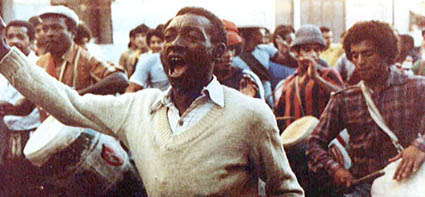
To understand how this rhythm, which is so strongly rooted in Uruguayan culture evolved, one would need to turn back the pages of African and South American history to look at how this contagious rhythm anchored at the shores of Montevideo. The text that follows are excerpts from books and articles written about candombe, as well as the viewpoint of individuals who have been close to this scene.
Montevideo, the capital of Uruguay, was founded by the Spanish in a process that was begun in 1724 and completed in 1730. African slaves were first introduced to the city in 1750. The roots of this population were not homogeneous, but rather a multi-ethnic swath of Africa that was culturally quite varied. 71% were sourced from the Bantu area, from Eastern and Equatorial Africa, while the rest came from non-Bantu Western Africa: Guinea, Senegal, Gambia, Sierra Leone, and the Gold Coast (what is today Ghana).
The Bantu area is an enormous cultural region of Africa with an extremely complex mosaic of ethnicities, consisting of over 450 groups with a linguistic heritage that overwhelms man's migratory limits: more than 20 linguistic groups and 70 dialects.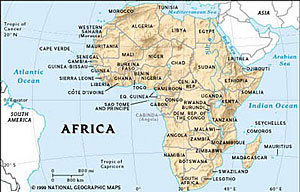
* these indices were compiled from documents of the Montevideo census of 1812, part of the nation's general archives.
It is believed that no less than ten million "ebony pieces" disembarked on the coasts of North and South America. This implies a bleeding of sixty million souls, if we consider that only one of every six victims of this human traffic ever made it alive to the harbors where they were to be auctioned. To understand what this meant, in demographic terms, it is sufficient to consider that at the beginning of the 19th Century, Buenos Aires had a population of merely 50 thousand.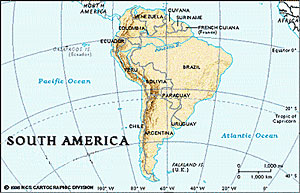
* from the prologue, written by Adolfo Colombres, to the book "El Candombe" by Ruben Carambula Biafra was dead, nobody wanted to get there
* from the candombe "Biafra" by Ruben Rada, in the introduction to the book "Los Tambores del Candombe" by Luis Ferreira
Who could care, anyhow, about some dying blacks?
Biafra, you're deserted and your drums are no longer around
While they could, your people sang:
Ne-ia ne-ia cumaia-nagata
Ne-ia ne-ia cumaia-nagata.
Candombe is what survives of the ancestral heritage of Bantu roots, brought by the blacks arriving at the Río de la Plata. The term is generic for all black dances: synonymous with and evoking the rituals of that race. Its musical spirit sums up the sorrows of the unfortunate slaves, who were hastily transplanted to South America to be sold and subjected to brutal work. These were pained souls, harboring an inconsolable nostalgia for their homeland. During colonial times, the newly arrived Africans called their drums tangó, and used this term to refer to the place where they gathered to perform their candombe dances; by extension, the dances themselves were also called tangós. With the word tangó, they defined the place, the instrument, and the dance of the blacks. 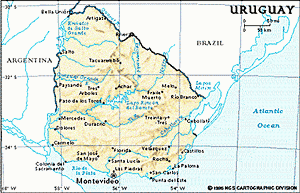
At the dawn of the 19th Century, Montevideo's Establishment was deeply troubled by the existence of the candombes, which they indistinctly called tambo or tangó. They banned them and harshly punished their participants, considering the dances a threat to public morals. In 1808 the citizens of Montevideo requested that the governor repress these dances even more severely and "prohibit the tangós of the blacks."
* from the book "Candombe" by Ruben Carambula
In Africa, Tambor and the person playing it are defined by the same word, Tambor.
"Kalunga kalungangue O-je o-je Imbambue."

The African poet Amos Totuola writes:
When the Tambor
Began to play the Tambor
Those who had been
Dead for years
Came forth to witness
How the Tambor played the Tambor.
It was the voice of the old "tatas" of candombe from the middle of the last Century, bellowing in the halls of black clandestine gatherings, sons and grandsons of those brought over in the holds of the slave ships. From 1751 to 1810, Montevideo received large contingents of Africans aboard vessels flying English and Spanish flags. While their culture was quickly repressed by the Spanish, their need for expression, their liberation, was maintained through their Tambor.
The Tambor of candombe is the presence of ancestral Africa in Uruguay.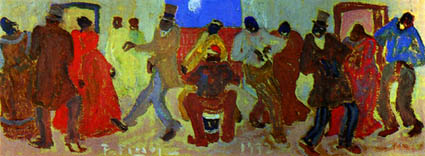
Candombe (24cm x 64cm) painting by Pedro Figari
Painted in the year 1932 ( he was 71 years of age at that time), one should consider that the image above was painted from Figari's memories of his childhood, which reflects the mid-nineteenth century candombe-gatherings, as described.
The houses where the slaves gathered, with their masters' permission, were off-limits to the general public in Montevideo of old. These were called tangós, and within their walls the slaves celebrated their festivities and ceremonies to the sound of the Tambor.
From this period of original celebrations in Uruguay, only the musical gathering is retained today, and find their principal manifestation in the "llamadas" of Barrio Sur and Palermo. In the sounds of the piano, the chico and the repique, the slaves have been able to preserve their ancestral memory.
* excerpts of the paper presented in August 1994, in Salvador, Bahia, at the Second International Congress of Afro-American Cultures by Aglimira "La Negra" Villalba
Impassioned by the rhythm, with a fleeting and naive joy, the dance is the reward for their tasks in the stables, for the jobs as porters that leave their agile bodies bent.
* written by by Samuel Oliver, excerpt from the book 'Figari', 1984, by Samuel Oliver from the collection "Artistas de Americas".
On the 28th of October, 1846, the president of the Republic, Joaquin Suarez, abolished slavery in Uruguay, in a process that began in 1825.
* information supplied by Virginia Martinez
Uruguay abolished slavery, documents described African dance rituals in Montevideo and the countryside known as tangós, with the accent on the second syllable. The word referred variously to the drums, the dances and the places where the religious rituals were held. Therein lies an intriguing musicological tale about the obscure origins of the tango, one of the best-known Latin American musical genres.

El Tango by Pedro Figari 35x50cm
The tango developed simultaneously in Montevideo and Buenos Aires. Although typically regarded as the creation of Italian and Spanish immigrants, the tango's music and the dance movements associated with it were deeply influenced by African dance and music, according to experts.
Argentina's black population all but disappeared, decimated in the 1800s by yellow fever, intermarriage and massive military recruitment of blacks, who then died in wars. In Uruguay, people of African descent accounted for about half the population two centuries ago; they now number about 189,000 in a nation of 3.2 million.
* excerpts from L.A. Times article by Sebastian Rotella
After independence was declared in 1825, civil wars disrupted the republic for almost 75 years. Military rule muzzled Uruguay from 1973 until democracy was restored in 1985, when many refugees came home. About 90 percent of Uruguayans - most of Spanish or Italian descent - live in cities, with Montevideo home to two-fifths. Education is compulsory and free, one of Latin America's most literate.
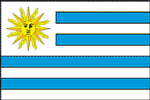
Oriental Republic of Uruguay
Short Form: Uruguay
Capital: Montevideo
Language: Spanish
* Text source: National Geographic Atlas of the World Revised Sixth Edition, 1995
Montevideo, Uruguay-On Sunday nights, the drummers of Barrio Sur assemble by firelight at an intersection in the historic black neighborhood in a tranquil corner of South America. Flames dance in a gutter bonfire lighted to tone the hides of the drums. Rows of drummers pound down the street in a blur of muscle, sweat and sound, filling the night with an African-derived rhythm known as candombe.
The street-corner ritual is part of a neglected chapter of the African diaspora. The drums tell a story of the profound impact that African culture has had in Uruguay and elsewhere in Latin America. In fact, Afro-Uruguayans celebrate an often-ignored piece of history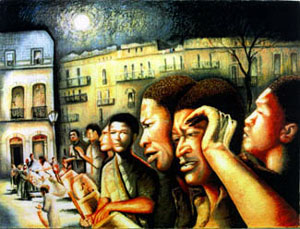
Luna, Barrio y Tamboril by Fernando Gomez Germano
* excerpts from L.A. Times article by Sebastian Rotella
The Creole, who once formed the whole nation, now prefers to be one of many. So that there may be greater glories in the land, glories must be forgotten. The memory of them is almost an act of remorse, the reproach of things abandoned without the intercession of a goodbye. It is a memory which is rescued, as the Creole destiny requires, for the gallantry and perfection of its sacrifice.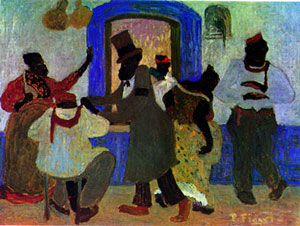
Nostalgias del Candombe by Pedro Figari 60x80cm
* written by Jorge Luis Borges, 'Figari', published in Buenos Aires Editorial, 1930, translated by David Balderstom, excerpt from the book 'Figari', 1984, by Samuel Oliver from the collection "Artistas de Americas".
The candombe rhythm is created by the use of three drums (tambores), tambor piano, tambor chico and tambor repique. When these three drums heat up, it's like nothing you've ever heard before. On the following page you will be able to hear the distinct sound of each of these three tambores
Drumbs of Candombe
Tambor Piano | Tambor Chico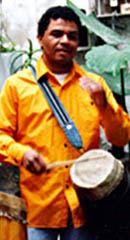 | Tambor Repique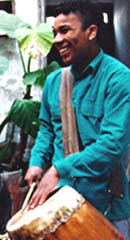 | ||
| The piano is the largest in size, and lowest in pitch of the three drums, holding the rhythmic base of candombe. Its rhythmic function is similar to the upright or electric bass. Its drumhead measures approximately sixteen inches in diameter. | The chico (small) name given because of its size and thinner drumhead, the highest in pitch of the three drums, and the rhythmic pendulum of the cuerda. Its drumhead measures approximately eight-and-one-half inches in diameter. | The repique's (ricochet) name tells us this drum embellishes candombe's rhythm with improvised phrases. Its drumhead measures approximately twelve inches in diameter. | ||
| Together these three tambores create candombe. Together these three drums are called a Cuerda |  | |||
Ansina: a social group in Montevideo, and one of the city's two uncontested candombe families. In the 1800s, when Uruguay joined other colonies in fighting for independence from Spain, Uruguayan national hero Jose Artigas led an elite division of troops against the colonists. One of his top advisors was Joaquin Lezina, known as Ansina, a freed slave who composed musical odes about his commander's exploits and is regarded by Afro-Uruguayans as an unheralded father of the nation. The heart of Montevideo's candombe community was once two tenements that are abandoned ruins today; Ansina (named after the historical figure) and Medio Mundo. The tenements were a center for candombe performances known as llamadas (drum calls), a direct offshoot of the slave dances.
Candombe: Afro-Uruguayan rhythmic and musical style, based on three tambores: piano, chico, and repique .
Chico (small): smallest and highest in pitch of the three tambores, its head measures 8.5 inches in diameter; the chico is the rhythmic pendulum of the cuerda.
Comparsa: a group that performs candombe during Montevidean carnival.
Cuareim: a social group in Montevideo, and one of the city's two uncontested candombe families.
Cuerda: family of three tambores (piano, chico, and repique); at a minimum, a cuerda consists of three people, each playing one of the three tambores.
Escobero: young man who leads the tambores down the streets, dancing with a headless broomstick twirling behind his back and up and down his arms; also called Escobillero.
Gramillero: knowledgeable grandfather wise in the ways of wild herbs and their healing properties; he is the true seed, exuding joy, experience,and pleasure contagious to all around him; king of the tambores, all-knowing sage full of memories and remembrances. El Gramillero embodiment of candombe.
Isla de Flores: the main street that joins Cuareim and Ansina, Montevideo's two main candombe social groups. For over a century, spontaneous cuerdas have paraded on this street, and continue to do so today. Also known by its second name, Carlos Gardel, after the greatest tango singer of all time.
Lubolo: a white performer who paints his face black to perform during Montevidean carnival.
Mama Vieja: the matron of candombe and the Gramillero's mate; dressed in her simple, handmade dress, she dances slowly and fans herself nervously while keeping the Gramillero dancing nearby.
Milongon: a slow candombe.
Morenos: pleasant term used to refer to black persons in Uruguay.
Piano: largest and lowest in pitch of the three tambores, its head measures 16 inches in diameter; responsible for the rhythmic base of candombe, its rhythmic function is similar to the upright or electric bass.
Repique (ricochet): its name tells us this tambor embellishes candombe's rhythm with improvised phrases; its head measures 12 inches in diameter.
Tambor: candombe drum ( tambor piano, tambor chico, tambor repique).
Candombe is for people of all ages. Uruguayan children begin to learn about candombe at a very early age.




No comments:
Post a Comment